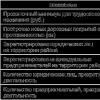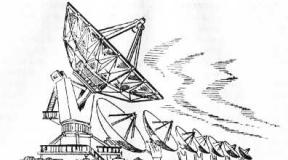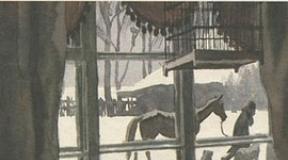What are carbohydrates and lipids. Structure and function of carbohydrates and lipids. Structure, examples and functions of carbohydrates
To use the preview of presentations, create a Google account (account) and sign in: https://accounts.google.com
Slides captions:
Carbohydrates. Lipids Chemical composition of cells Luzganova I.N., teacher of biology, MBOU secondary school named after A.M. Gorky, Karachev
Lesson objectives: To find out what processes, which are a qualitative leap from inanimate to living nature, are being investigated by scientists at the molecular level. And to study the composition, structure and functions of carbohydrates, lipids
SUBSTANCES in the composition of the body INORGANIC ORGANIC Compounds Ions Small molecules Macromolecules (biopolymers) Water Salts, acids, etc. Anions Cations Monosaccharides Amino acids Nucleotides Lipids Other Polysaccharides Proteins Nucleic acids
Organic substances These are chemical compounds that contain carbon atoms. Characteristic only for living organisms Organic substances fats proteins carbohydrates (lipids) nucleic acids
Biopolymers Large organic compounds are called macromolecules. Macromolecules consist of repeating, similar in structure, low molecular weight compounds linked together by a covalent bond - MONOMERS. A macromolecule formed from monomers is called a POLYMER.
Organic compounds that make up living cells are called BIOPOLYMERS. BIOPOLYMERS are linear or branched chains containing many monomer units. Biopolymers
Biopolymers POLYMERS HOMOPOLYMERS HETEROPOLYMERS are represented by one type of monomers (A - A - A - A ...) are represented by several different monomers (A - B - C - A - D ...) REGULAR IRREGULAR group of monomers is periodically repeated ... A-B-A -B-A-B ... ... A-A-B-B-B-A-A-B-B-B ... ... A-B-C-A-B-C-A-B-C ... no visible repeatability of monomers …А-В-А-А-В-А-В-В-В-А... А-В-С-В-В-С-А-С-А-А-С
Properties of biopolymers Biopolymers Number, composition, order of monomers Construction of many variants of molecules Basis for the diversity of life on the planet
Chemical composition Content in the cell Structure (structure) Properties Functions Biopolymers PLAN CHARACTERISTICS:
Organic substances Organic substances fats proteins carbohydrates (lipids) nucleic acids The carbon atoms connected to each other form various structures - the backbone of the molecules of organic substances:
CARBOHYDRATES Cells C, O, H C n (H 2 O) n P - 70-90% F - 1-2% of dry weight 1-2% C 5 H 10 O 5 C 3 H 6 O 3 C 6 H 12 O 6 C 4 H 8 O 4 Formed from water (H 2 O) and carbon dioxide (CO 2) during photosynthesis occurring in the chloroplasts of green plants
Mono– Oligo(di)– Poly– SACHARIDES C 3 Trioses (PVA, lactic acid) C 4 Tetroses C 5 Pentoses (ribose, fructose, deoxyribose) C 6 Hexoses (glucose, galactose) Sucrose (glucose + fructose) Maltose (glucose + glucose) Lactose (glucose + galactose) Starch Cellulose Glycogen Chitin (M) (M + M) (M + M + ... + M) SIMPLE COMPLEX CARBOHYDRATES All carbohydrates have a carbonyl group:
Linear form Fructose Glucose MONOSACCHARIDES: Properties: Colorless, sweet, soluble, crystallize, pass through membranes EASILY Monosaccharide molecules are linear chains of carbon atoms. In solutions, they take a cyclic form Cyclic form Linear form Cyclic form Galactose Are an important source of energy for any cell
Ribose Deoxyribose MONOSACCHARIDES: Properties: Colorless, sweet, soluble, crystallize, pass through membranes EASILY Monosaccharide molecules are linear chains of carbon atoms. Takes a cyclic form in solutions Included in nucleic acids
Colorless Sweet Soluble DISACCHARIDES: S a charose (glucose + fructose) M a l t o s a (glucose + glucose) L a c t o s a (glucose + galactose) Properties:
POLYSACCHARIDES: Cellulose Molecules have a linear (unbranched) structure, as a result of which cellulose easily forms fibers. It is insoluble in water and does not have a sweet taste. It is made up of plant cell walls. Performs a supporting and protective function.
POLYSACCHARIDES: Starch is deposited in the form of inclusions and serves as a reserve energy substance of the plant cell
POLYSACCHARIDES: Glycogen A molecule is made up of approximately 30,000 glucose units. It resembles starch in structure, but is more branched and more soluble in water. It is deposited in the form of inclusions and serves as a reserve energy substance of the animal cell.
POLYSACCHARIDES: Chitin An organic substance from the group of polysaccharides that forms the outer hard cover and skeleton of arthropods, fungi and bacteria and is included in cell membranes (C 8 H 13 O 5 N)
The building envelope of cellulose in plant cells, chitin in the skeleton of insects and in the cell wall of fungi provide cells and organisms with strength, elasticity and protection against large moisture loss. FUNCTIONS OF CARBOHYDRATES
Structural Monosugars can combine with fats, proteins and other substances. For example, ribose is part of all RNA molecules, and deoxyribose is part of DNA. FUNCTIONS OF CARBOHYDRATES
Storage Mono- and oligosaccharides, due to their solubility, are quickly absorbed by the cell, easily migrate throughout the body, and therefore are unsuitable for long-term storage. The role of the energy reserve is played by huge water-insoluble molecules of polysaccharides. Plants have starch, while animals and fungi have glycogen. FUNCTIONS OF CARBOHYDRATES Glycogen in liver cells
Transport In plants, sucrose serves as a soluble reserve saccharide, and a transport form that is easily transported throughout the plant. Signal There are polymers of sugars that are part of cell membranes; they provide interaction of cells of the same type, recognition by cells of each other. (If the separated liver cells are mixed with kidney cells, they will independently disperse into two groups due to the interaction of the same type of cells: kidney cells will join into one group, and liver cells into another). FUNCTIONS OF CARBOHYDRATES
Energy (17.6 kJ) Mono - and oligosaccharides are an important source of energy for any cell. Splitting, they release energy, which is stored in the form of ATP molecules, which are used in many life processes of the cell and the whole organism. FUNCTIONS OF CARBOHYDRATES Protective (“mucus”) Viscous secretions (mucus) secreted by various glands are rich in carbohydrates and their derivatives (for example, glycoproteins). They protect the esophagus, intestines, stomach, bronchi from mechanical damage, penetration of harmful bacteria and viruses.
CARBOHYDRATES C, O, H COMPLEX Mono-Oligo(di)-Poly- SACCHARIDES Trioses (PVK, lactic acid) Tetroses Pentoses (ribose, fructose, deoxyribose) Hexoses (glucose, galactose) Sucrose (glucose+fructose) Maltose (glucose+glucose) Lactose (glucose+galactose) Starch Cellulose Glycogen Chitin sweet soluble crystallize passage. h/w membranes EASILY tasteless dissolve crystallize pass h/w membranes NOT at
С, О, Н alcohol (glycerol) fatty acids + HYDROPHOBIC DISSOLVE IN GASOLINE, ETHER, CHLOROFORM 5-10%, in fat cells up to 90% PROPERTIES: LIPIDS
PHOSPHOLIPIDS STEROIDS LIPOPROTEINS GLYCOLIPIDS TRIGLYCERIDES WAX LIPID Types of lipids
FATS (solid) OILS (liquid) TRIGLYCERIDES Alcohol glycerol + fatty acids Alcohol + unsaturated (saturated) fatty acids Types of lipids
PHOSPHOLIPIDS Glycerol + fatty acids + phosphoric acid residue CELL MEMBRANES Types of lipids
Esters of Higher Fatty Acids and Monohydric High Molecular Alcohols WAX Plant Animals Lipid Species
STEROIDS VITAMINS (K, E, D, A) HORMONES (adrenal, sex) Alcohol cholesterol + fatty acids Types of lipids
LIPOPROTEINS GLYCOLIPIDS Lipids + carbohydrates Lipids + proteins Types of lipids Almost all lipoproteins are formed in the liver. The main function of lipoproteins is the transport of lipid components to tissues. They are localized mainly on the outer surface of the plasma membrane, where their carbohydrate components are among other cell surface carbohydrates. can participate in intercellular interactions and contacts. Some of them are antigens.
FUNCTIONS OF LIPID
Supporting structural function of lipids Lipids are involved in the construction of cell membranes of all organs and tissues, causing their semi-permeability, participate in the formation of many biologically important compounds.
Energy FUNCTIONS OF LIPIDS Lipids account for 25-30% of all energy needed by the body. When 1 g of fat is oxidized, 39.1 kJ of energy is released Fat-soluble vitamins K, E, D, A are coenzymes (non-protein part) of enzymes Catalytic Hormones - steroids (sex, adrenal glands) can change the activity of many enzymes, enhancing or suppressing the action of enzymes and thereby regulating the course of physiological processes in the body Regulatory (hormonal)
Protective FUNCTIONS OF LIPIDS Mechanical (shock absorption, the fat layer of the abdominal cavity protects internal organs from damage) Thermoregulatory (heat-insulating) - fat does not conduct heat and cold well. Electrical insulating (myelin sheath of nerve fibers)
Source of metabolic water LIPID FUNCTIONS 1 kg of fat breaks down 1.1 kg of water
LIPIDS C, O, H alcohol (glycerol) fatty acids + HYDROPHOBIC 5-10%, in fat cells up to 90% FATS (solid) OILS (liquid) PHOSPHO-LIPIDS STEROIDS LIPOPROTEINS GLYCOLIPIDS-FUNCTIONS-TRIGLYCERIDES Alcohol glycerol + fatty acids Alcohol + unsaturated (limiting) fatty acids Alcohol + unsaturated fatty acids Glycerol + fatty acids + phosphoric acid residue Esters of higher fatty acids and monohydric high molecular weight alcohols WAX Lipids + carbohydrates Lipids + proteins Alcohol cholesterol + fatty acids VITAMINS (A, D. E , K) HORMONES (adrenal glands, sex) Support-structural Regulatory (hormonal) Energy 39.1 kJ Catalytic Storage Metabolic water source Protective (thermoregulatory) Gasoline, ether, chloroform
The mass fraction of carbohydrates in wildlife is greater than other organic compounds. In the cells of animals and fungi, carbohydrates are contained in a small amount (about 1% of dry weight, in the cells of the liver and muscles - up to 5%), while in plant cells their content is much higher (60 - 90%). Carbohydrates are formed mainly as a result of photosynthesis. Heterotrophic organisms obtain carbohydrates from food or synthesize them from other organic compounds (fats, amino acids, etc.).
Carbohydrates are organic compounds in which the ratio of carbon, oxygen basically corresponds to the formula (CH 2 O) n, where n \u003d 3 and more. However, there are carbohydrates in which this ratio is somewhat different, and some contain nitrogen, phosphorus or sulfur atoms.
Carbohydrates include monosaccharides, oligosaccharides and polysaccharides.
Monosaccharides - highly soluble in substances, have a sweet taste. Consider the structure of monosaccharides using glucose as an example. Its molecular formula is C 6 H 12 0 6 .
Glucose molecule
Monosaccharides are classified according to the number of carbon atoms in their molecules. The most important for wildlife are pentoses (compounds with five carbon atoms) and hexoses (compounds with six carbon atoms). Common hexoses, in addition to glucose, are fructose and galactose. Of the pentoses, ribose and deoxyribose are common, the residues of which are part of the nucleic acid monomers. Monosaccharides are able to combine with each other using -OH groups. In this case, it is formed between two monosaccharide residues through an oxygen atom (-O-).
 Scheme of the formation of polysaccharides on the example of cellulose (a fragment of a molecule)
Scheme of the formation of polysaccharides on the example of cellulose (a fragment of a molecule) Oligosaccharides and polysaccharides are composed of monosaccharide residues. Oligosaccharides are polymeric carbohydrates in which from 2 to 10 monosaccharide units are connected by covalent bonds. For example, disaccharides are formed by two monosaccharide residues. In nature, such disaccharides are common: common food sugar - sucrose (consists of glucose and fructose residues) and milk sugar - lactose (consists of glucose and galactose residues).
As a result of the interaction of monosaccharides, chains of hundreds and thousands of residues can be formed - polysaccharides. These compounds are poorly soluble in water and do not have a sweet taste. In nature, polysaccharides formed from glucose residues are common, these are cellulose, glycogen and starch. Another common polysaccharide in nature, chitin, consists of nitrogen-containing derivatives of glucose.
The functions of carbohydrates are quite diverse. The energy function is due to the fact that as a result of the complete breakdown of 1 g of carbohydrates, 17.6 kJ of energy is released. Part of this energy ensures the functioning of the body, and part is released in the form of heat. The greatest amount of energy is released as a result of the oxidation of carbohydrates with oxygen, however, the breakdown of carbohydrates with the release of energy can occur in other cases. This is important for organisms that exist in conditions of lack or absence of oxygen.
Polysaccharides can accumulate in cells, that is, they can perform a reserve function. Glycogen accumulates in animal and fungal cells, and starch accumulates in plant cells. The construction (structural) function of carbohydrates is that polysaccharides are part of certain structures. So, chitin forms the external skeleton of arthropods and is contained in the cell wall of fungi, and cellulose is found in the cell wall of plants. Carbohydrates associated with and lipids are located outside the plasma membrane of the animal cell and the cell wall of bacteria. Special compounds of carbohydrates with proteins (mucopolysaccharides) perform the function of lubrication in the organisms of vertebrates and humans - they are part of the liquid, lubricates the surfaces of the joints.
Polysaccharide chains can be linear in space or branch, which is associated with their functions. The chains of polysaccharides, which are part of the structures of a cell or organism, are interconnected by numerous bonds, which ensures the strength and chemical resistance of these substances. However, most polysaccharides are reserve substances of animal and plant cells, they have numerous branched chains, as a result of which these molecules are quickly broken down into glucose in the cell at many points simultaneously.
Structure, properties and biological role of lipids
Every cell in the body contains lipids. Lipids are derivatives of fatty acids and polyhydric alcohols or aldehydes. Fatty acids are organic acids with a chain of four or more (up to 24) carbon atoms, usually a straight chain. Some lipids have a slightly different structure, but are also poorly soluble in water.
Lipids are hydrophobic, but dissolve well in non-polar solvents: benzene, chloroform, acetone.
A large group of lipids are fats. Fats are esters of the trihydric alcohol glycerol and three unbranched fatty acid residues. One of the most important functions of fats is energy. In the case of complete breakdown of 1 g of fat, 38.9 kJ of energy is released - twice as much as for the complete breakdown of a similar amount of carbohydrates or proteins. The reserve function is that fats are contained in the cytoplasm of cells in the form of inclusions - in adipose cells, sunflower seeds, etc. Fat reserves can be used by organisms as reserve nutrients and as a source of metabolic water (when 1 g of fat is oxidized, about ml of water).
Accumulating in the subcutaneous adipose tissue of animals, fats protect the body from the effects of sudden changes in temperature, performing a heat-insulating function. This function of fats is due to their low thermal conductivity. Fat reserves in the body can also perform a protective function. In particular, they protect internal organs from mechanical damage.
Compounds similar in structure to fats are waxes, a layer of which covers the leaves and fruits of terrestrial plants, the surface of the chitinous skeleton of many arthropods, preventing excessive evaporation of water from the surface of the body.
Steroids form a separate group of lipids. The most important steroid of the animal organism is cholesterol, a component of cell membranes, as well as a precursor for the synthesis of vitamin D, adrenal and gonadal hormones.
Among lipids, there are compounds formed as a result of the interaction of simple lipid molecules with other substances. These include lipoproteins (compounds of lipids and proteins), glycolipids (lipids and carbohydrates), phospholipids (containing orthophosphoric acid residues)
Home > LectureLecture 3. Carbohydrates, lipidsCarbohydrates. Carbohydrates, or saccharides, are organic substances that contain carbon, oxygen, and hydrogen. The chemical composition of carbohydrates is characterized by their general formula C m (H 2 O) n, where m ≥ n. Carbohydrates make up about 1% of the mass of animal cells, and up to 5% in liver and muscle cells. Plant cells are the richest in carbohydrates (up to 90%). The number of hydrogen atoms in carbohydrate molecules is usually twice the number of oxygen atoms (that is, as in a water molecule). Hence the name carbohydrates. There are two groups of carbohydrates: simple and complex. Simple carbohydrates. Simple carbohydrates are called monosaccharides, since they are not hydrolyzed during digestion, unlike complex ones, which decompose upon hydrolysis to form monosaccharides. The general formula of simple sugars is (CH 2 O) n, where n ≥ 3. Depending on the number of carbon atoms in a monosaccharide molecule, there are: trioses (3C), tetroses (4C), pentoses (5C), hexoses (6C), heptoses ( 7C). In nature, pentoses and hexoses are the most widespread. V
Rice. . Pentoses:
1 - ribose; 2 - deoxyribose.
The most important monosaccharides: from pentoses - ribose (C 5 H 10 O 5) and deoxyribose (C 5 H 10 O 4), which are part of the nucleotides of DNA, RNA and ATP. Deoxyribose differs from ribose in that it has a hydrogen atom at the second carbon atom, and not a hydroxyl group like ribose. AND
Rice. . Linear and cyclic structure of the glucose molecule.
From hexoses, the most common are glucose, fructose and galactose (general formula C 6 H 12 O 6). Glucose (grape sugar) is the primary source of energy for cells. It is part of complex carbohydrates. Mandatory component of blood. A decrease in its amount leads to an immediate disruption of the vital activity of nerve and muscle cells. Being in cells, it regulates osmotic pressure. Fructose found in free form in fruits. Especially a lot of it in honey, fruits. Significantly sweeter than glucose and other sugars. Included in the composition of oligo- and polysaccharides, is involved in maintaining the turgor of plant cells. Galactose is also a spatial isomer of glucose. Together with glucose, they form the most important disaccharide of milk - lactose called milk sugar. Easily converted to glucose. M

Rice. . Glucose isomers:
1 - -isomer; 2 - -isomer.
Monosaccharide molecules can have the form of straight chains or cyclic structures (Fig.). For pentoses and hexoses, it is the cyclic structure that is most characteristic; linear molecules are very rare. Molecules of disaccharides and polysaccharides are also formed by cyclic forms of monosaccharides. Monosaccharides can be presented in the form of - and -isomers (Fig.). The hydroxyl group at the first carbon atom can be located both under the ring plane (-isomer) and above it (-isomer), -isomers form starch and glycogen molecules, -isomers form cellulose. Properties of monosaccharides: low molecular weight, sweet taste, easily soluble in water, crystallize, are reducing (restoring) sugars. Complex carbohydrates. Complex carbohydrates are called carbohydrates, the molecules of which, during hydrolysis, break down to form monosaccharides. Their composition is expressed by the general formula Сm(H 2 O)n, where m>n. Complex carbohydrates are divided into oligosaccharides and polysaccharides.O

Rice. . formation of a disaccharide.
Ligosaccharides . Oligosaccharides are complex carbohydrates containing from 2 to 10 monosaccharide residues. Depending on the number of monosaccharide residues included in the oligosaccharide molecules, disaccharides, trisaccharides, tetrasaccharides, etc. are distinguished. Disaccharides are the most widely distributed in nature. disaccharides- oligosaccharides, the molecules of which are formed by two monosaccharide residues. Disaccharides are formed as a result of the condensation of two monosaccharides (most often hexoses) (Fig.). The bond that occurs between two monosaccharides is called glycosidic. Usually it is formed between the 1st and 4th carbon atoms of neighboring monosaccharide units - 1,4-glycosidic bond. The most important disaccharides are maltose, lactose, and sucrose. Maltose (malt sugar) It is made up of two α-glucose residues. The disaccharide is highly soluble in water. It is formed as a result of the condensation reaction of two molecules of -glucose or an enzyme maltase during the hydrolysis of starch. Sucrose (cane, beet sugar) It is made up of α-glucose and fructose residues. Easily soluble in water. Widely distributed in plants. Carbohydrates formed during photosynthesis, in the form of sucrose, flow from the leaves. Sucrose is readily converted to starch and glycogen. It plays a huge role in the nutrition of animals and humans. Sucrose is mainly obtained from sugar beet and sugar cane.

Rice. . The most important disaccharides
Lactose (milk sugar) formed by the remnants galactose and -glucose. Poorly soluble in water. Included in milk. It is a source of energy for young mammals. It is found in free form in some plants. It is used in the microbiological industry for the preparation of nutrient media. Properties of oligosaccharides: relatively low (several hundred) molecular weight, good solubility in water, easy to crystallize, usually have a sweet taste, can be both reducing and non-reducing. Polysaccharides. High molecular weight organic substances, biopolymers, the monomers of which are simple carbohydrates. Most often, the monomer of polysaccharides is glucose, sometimes galactose and other sugars. As a rule, several hundred monomeric units are included in the composition of polysaccharides. P
Fig.267. Formation of a branched polysaccharide.
Olisaccharides are formed as a result of a polycondensation reaction (Fig.). If only 1,4-glycosidic bonds are present in the polysaccharide molecule, then a linear, unbranched polymer (cellulose) is formed. If both 1,4 and 1,6-glycosidic bonds are present, the polymer will be branched (glycogen). A 1,6-glycosidic bond is formed between monosaccharide residues that make up different linear chains. The most important polysaccharides are starch, glycogen, cellulose, chitin, murein. Starch- the main reserve carbohydrate of plants. The general formula is (C 6 H 10 O 5) n, where n is the number of -glucose residues. Insoluble in cold water. In hot water, it forms a solution resembling colloidal (starch paste) in properties. The starch molecule is approximately 20% amylose and 80% of amylopectin. The linear amylose chains consist of several thousand glucose units and are capable of coiling into a more compact form. Amylopectin branches intensively, and due to this, its compactness is ensured.


Rice. . Formation of a triglyceride molecule.
Most fatty acids contain an even number of carbon atoms in the "tail", from 14 to 22 (most often 16 or 18). In addition, the hydrocarbon tail may contain varying amounts of double bonds. By the presence or absence of double bonds in the hydrocarbon tail, saturated fatty acids, not containing double bonds in the hydrocarbon tail and unsaturated fatty acids having double bonds between carbon atoms (-CH \u003d CH-). If saturated fatty acids predominate in triglycerides, then they are solid at room temperature (fats), if unsaturated - liquid ( oils). The density of fats is lower than that of water, so they float in water and are on the surface. Wax- a group of simple lipids, which are esters of higher fatty acids and higher high-molecular alcohols. They are found both in the animal and plant kingdoms, where they perform mainly protective functions. In plants, for example, they cover leaves, stems and fruits with a thin layer, protecting them from wetting with water and the penetration of microorganisms. The shelf life of fruits depends on the quality of the wax coating. Honey is stored under the cover of beeswax and larvae develop. to complex lipids include phospholipids, g

Rice. 269. Phospholipid molecule
Lycolipids, lipoproteins, steroids, steroid hormones, vitamins A, D, E, K. F

Rice. . Bilayer of phospholipids
membranous
Ospholipids are esters of polyhydric alcohols with higher fatty acids containing a phosphoric acid residue (Fig.). Sometimes additional groupings (nitrogenous bases, amino acids) can be associated with it. As a rule, a phospholipid molecule has two higher fatty acid residues and one phosphoric acid residue. Phospholipids are present in all cells of living beings, participating mainly in the formation of the phospholipid bilayer of cell membranes - phosphoric acid residues are hydrophilic and always directed towards the outer and inner surfaces of the membrane, and hydrophobic tails are directed towards each other inside the membrane. Glycolipids are carbohydrate derivatives of lipids. The composition of their molecules, along with polyhydric alcohol and higher fatty acids, also includes carbohydrates. They are localized predominantly on the outer surface of the plasma membrane, where their carbohydrate components are among other cell surface carbohydrates. Lipoproteins- lipid molecules associated with proteins. There are a lot of them in membranes, proteins can penetrate the membrane through, are located under or above the membrane, can be immersed in the lipid bilayer to different depths. Lipoids- fat-like substances. These include steroids(widespread in animal tissues cholesterol and its derivatives - hormones of the adrenal cortex - mineralocorticoids, glucocorticoids, estradiol and testosterone - female and male sex hormones, respectively). Lipoids include terpenes (essential oils, on which the smell of plants depends), gibberellins (growth substances of plants), some pigments (chlorophyll, bilirubin), fat-soluble vitamins (A, D, E, K). Functions of lipids.
| Examples and explanations |
|
| Energy | The main function of triglycerides. When splitting 1 g of lipids, 38.9 kJ are released |
| Structural | Phospholipids, glycolipids and lipoproteins are involved in the formation of cell membranes. |
| Reserve | Fats and oils are a reserve food substance in animals and plants. Important for animals that hibernate during the cold season or make long transitions through areas where there are no food sources Plant seed oils are needed to provide energy to the seedling. |
| Protective | Layers of fat and fatty capsules provide shock absorption of internal organs. Layers of wax are used as a water-repellent coating in plants and animals. |
| Thermal insulation | Subcutaneous fatty tissue prevents the outflow of heat into the surrounding space. Important for aquatic mammals or mammals living in cold climates. |
| Regulatory | Gibberellins regulate plant growth. The sex hormone testosterone is responsible for the development of male secondary sexual characteristics. The sex hormone estrogen is responsible for the development of female secondary sexual characteristics and regulates the menstrual cycle. Mineralocorticoids (aldosterone, etc.) control water-salt metabolism. Glucocorticoids (cortisol, etc.) are involved in the regulation of carbohydrate and protein metabolism. |
| Source of metabolic water | When 1 kg of fat is oxidized, 1.1 kg of water is released. Important for desert dwellers. |
| catalytic | Fat-soluble vitamins A, D, E, K are enzyme cofactors, i.e., these vitamins themselves do not have catalytic activity, but without them, enzymes cannot perform their functions. |
The need to develop materials on nutrition for schoolchildren is dictated by depressing data on the state of health of modern schoolchildren, the lack of a food culture as a component of a healthy lifestyle.
Carbohydrates are complex organic compounds composed of carbon, oxygen and hydrogen atoms.
Distinguish between simple and complex carbohydrates. Simple carbohydrates are called monosaccharides. Complex carbohydrates are polymers in which monosaccharides play the role of monomers. Two monosaccharides form a disaccharide, three a trisaccharide, and many a polysaccharide.
All monosaccharides are colorless substances, readily soluble in water. Almost all of them have a pleasant sweet taste. The most common monosaccharides are glucose, fructose, ribose, and deoxyribose. The sweet taste of fruits and berries, as well as honey, depends on the content of glucose and fructose in them. Ribose and deoxyribose are constituents of nucleic acids and ATP.
Di- and trisaccharides, like monosaccharides, dissolve well in water and have a sweet taste. With an increase in the number of monomer units, the solubility of polysaccharides decreases, and the sweet taste disappears.
Beet (or cane) and milk sugar are important among disaccharides, starch (in plants), glycogen (in animals), fiber (cellulose) are widespread among polysaccharides. Wood is almost pure cellulose. The monomers of these polysaccharides is glucose.
The biological role of carbohydrates.
Carbohydrates play the role of a source of energy necessary for the cell to carry out various forms of activity. For the activity of the cell - movement, secretion, biosynthesis, luminescence, etc. - energy is needed. Structurally complex, energy-rich, carbohydrates undergo deep cleavage in the cell and, as a result, turn into simple, energy-poor compounds - carbon monoxide (IV) and water (CO 2 and H 2 O). During this process, energy is released. When splitting 1 g of carbohydrate, 17.6 kJ is released.
In addition to energy, carbohydrates also perform a building function. For example, the walls of plant cells are made of cellulose.
Lipids.
Lipids are organic substances that are insoluble in water, but soluble in gasoline, ether, and acetone.
Of the lipids, the most common and well-known are fats. The fat content in cells is usually low: 5-10% (of dry matter). There are, however, cells in which about 90% fat. In animals, such cells are found under the skin, in the mammary glands, and in the omentum. Fat is found in the milk of all mammals. In some plants, a large amount of fat is concentrated in seeds and fruits, such as sunflower, hemp, walnut.
In addition to fats, other lipids are also present in cells, such as lecithin, cholesterol. Lipids include some vitamins (A, D) and hormones (for example, sex hormones).
The biological significance of lipids is great and varied. Let us first of all note their construction function. Lipids are hydrophobic. The thinnest layer of these substances is part of the cell membranes. Great value of the most common of lipids - fat - as a source of energy. Fats are able to oxidize in the cell to carbon monoxide (IV) and water. Breaking down fat releases twice as much energy as breaking down carbohydrates. Animals and plants store fat in reserve and consume it in the process of life. The high fat content of the seeds is necessary to provide the seedling with energy until it becomes self-feeding.
It should be noted further the importance of fat as a source of water. From 1 kg of fat during its oxidation, almost 1.1 kg of water is formed. This explains how some animals are able to go quite a long time without water. Camels, for example, crossing a waterless desert, may go without drinking for 10 to 12 days. Bears, marmots and other hibernating animals do not drink for more than two months. These animals receive the water necessary for life as a result of fat oxidation. In addition to structural and energy functions, lipids perform protective functions; fat has a low thermal conductivity. It is deposited under the skin, forming significant accumulations in some animals. So, in a whale, the thickness of the subcutaneous layer of fat reaches 1 m, which allows this animal to live in the cold water of the polar seas.
- biological polymers
- Carbohydrates and their structure
- Functions of carbohydrates
- Lipids, their structure and functions
The composition of cells includes many organic compounds: carbohydrates, proteins, lipids, nucleic acids and other compounds that are not found in inanimate nature. Organic substances are chemical compounds that contain atoms carbon.
Carbon atoms are able to enter into a strong covalent bond with each other, forming a wide variety of chain or ring molecules.
The simplest carbon-containing compounds are hydrocarbons, compounds that contain only carbon and hydrogen. However, most organic, i.e., carbon, compounds also contain other elements (oxygen, nitrogen, phosphorus, sulfur).
Organic compounds - carbon-containing substances characteristic of wildlife - average 20-30% of the mass of cells of living organisms. The main properties of cells and organisms are determined by organic polymers: proteins, carbohydrates, nucleic acids, as well as complex compounds - fats and a number of hormone molecules, pigments, individual nucleotides, in particular ATP (adenosine triphosphoric acid).
- Biological polymers (biopolymers).
Biological polymers are organic compounds that make up the cells of living organisms and their metabolic products.
Polymer(from the Greek "poly" - a lot) - a multi-link chain in which a link is any relatively simple substance - monomer. Monomers, connecting with each other, form chains consisting of thousands of monomers. If we designate the type of monomer with a specific letter, for example A, then the polymer can be depicted as a very long combination of monomer units: A-A-A-A-...-A. These are, for example, organic substances known to you: starch, glycogen, cellulose, etc. Biopolymers are proteins, nucleic acids, polysaccharides. The properties of biopolymers depend on the structure of their molecules: on the number and variety of monomeric units that form the polymer. If you combine two types of monomers A and B together, you can get a very large set of different polymers. The structure and properties of such polymers will depend on the number, ratio and order of alternation, i.e., the position of the monomers in the chains. A polymer in which a group of monomers repeats periodically is called regular. Such, for example, are schematically depicted polymers with a regular alternation of monomers:
A B A B A B A B...
A A B B A A B B...
A BBBBBB A...
However, much more variants of polymers can be obtained in which there is no visible pattern in the repeatability of monomers. Such polymers are called irregular.
Let us assume that each of the monomers determines some property of the polymer. For example, monomer A determines high strength, and monomer B determines electrical conductivity. Combining these two monomers in different ratios and alternating them in different ways, one can obtain a huge number of polymeric materials with different properties. If we take not two types of monomers (A and B), but more, then and the number of variants of polymer chains will increase significantly. It turned out that the combination and permutation of several types of monomers in long polymer chains provides the construction of many variants and determines the various properties of biopolymers that are part of all organisms. This principle underlies the diversity of life on our planet.
2. Carbohydrates and their structure. In the composition of the cells of all living organisms, they are widely distributed carbohydrates. Carbohydrates are organic compounds made up of carbon, hydrogen and oxygen. In most carbohydrates, hydrogen and oxygen are, as a rule, in the same ratios as and in water (hence their name - carbohydrates). The general formula for such carbohydrates is C n (H 2 0) m. An example is one of the most common carbohydrates - glucose, the elemental composition of which is C 6 H 12 0 6 (Fig. 2). Glucose is simple sugar. Several residues of simple sugars combine with each other and form complex sugars. Milk contains milk sugar, which consists of the remains of molecules of two simple sugars (disaccharides). Milk sugar is the main source of energy for the young of all mammals. Thousands of residues of molecules of identical Sugars, connecting with each other, form biopolymers - polysaccharides. There are many different polysaccharides in the composition of living organisms: in plants, this starch(Fig. 3), in animals - glycogen, also consisting of thousands of glucose molecules, but even more branched. Starch and glycogen play the role of accumulators of energy necessary for the vital activity of body cells. Potatoes, grains of wheat, rye, corn, etc. are very rich in starch.
Carbohydrates or saccharides, - organic substances with the general formula C p (H 2 0) l, where P at least three. The ratio of hydrogen and oxygen in the formula of carbohydrates is similar to their ratio in the water molecule, hence their name. Plant cells are the richest in carbohydrates, in which the content of saccharides in some cases reaches 90% of the dry mass (potato tubers, seeds), carbohydrates are contained in an animal cell in an amount of 2-5%. All carbohydrates are divided into three groups: monosaccharides, disaccharides and polysaccharides. Several monosaccharide molecules, connecting with each other with the release of water, form a polysaccharide molecule, a polymer: -
- monosaccharides (simple sugars) are divided depending on the number of carbon atoms in the molecule into: trioses containing 3 carbon atoms, tetroses - 4, pentoses - 5, hexoses - 6 carbon atoms. Of the trioses, glycerol and its derivatives (lactic and pyruvic acids) are of great importance. From tetroses - erythrosis. Pentoses include ribose and deoxyribose, which are part of RNA and DNA. Among hexoses, glucose, fructose and galactose are of the greatest importance for living organisms, their general formula is C 6 H 12 O 6. Monosaccharides are soluble in water. They are the main source of energy in the cell. Oxidation of 1 g of glucose gives 17.1 kJ of energy;
- disaccharides, oligosaccharides They are made up of two monosaccharides linked by a glycosidic bond. These include sucrose, lactose and maltose. Dissolve in water, have a sweet taste;
- polysaccharides - high-molecular carbohydrates, consisting of a large number of monosaccharides, their molecular weight is large, the molecules have a linear or branched structure. Functionally, polysaccharides of reserve and structural purposes are distinguished. Insoluble in cold water starch- the main reserve polysaccharide of plants; found in large quantities in potato tubers, fruits, seeds. Glycogen- a polysaccharide contained in the tissues of the body of humans and animals, as well as in fungi and yeast, plays an important role in the transformation of carbohydrates in cells. fiber(cellulose) is the main structural polysaccharide of plant cell membranes. It contains almost 50% of all carbon in the biosphere. Polysaccharides are divided into homo- and heteropolysaccharides. The first consist of monosaccharides of only one type; the second - from monosaccharides of different types and their derivatives. Complexes with proteins are called glycoproteins, with fats - glycolipids.
3. Functions of carbohydrates: energy, structural, signal (glycoprotein). The secrets of various glands of animals and humans contain carbohydrates and their derivatives. In plants, polysaccharides also perform a supporting function.
4. Lipids Lipids and lipoids (Greek lipos - fat) - fats and fat-like substances - organic compounds with different structures. They do not dissolve in water, but are readily soluble in organic solvents: ether, gasoline, chloroform, etc. The fat content in cells is usually low, 5-15% of dry weight, but adipose tissue cells can contain fat up to 90% of dry weight. .
Lipids are diverse in structure. All of them, however, have one thing in common: they are all non-polar. Therefore, they dissolve in such non-polar liquids as chloroform, ether, but are practically insoluble in water. Lipids include fats and fat-like substances. In the cell, during the oxidation of fats, a large amount of energy is produced, which is spent on various processes. This is the energy function of fats. Fats can accumulate in cells and serve as a reserve nutrient. In some animals (for example, whales, pinnipeds), a thick layer of subcutaneous fat is deposited under the skin, which, due to low thermal conductivity, protects them from hypothermia. Some lipids are hormones and are involved in the regulation of the physiological functions of the body. Lipids containing phosphorus (phospholipids) are the most important component of cell membranes, that is, they perform a structural function. According to the chemical structure, lipids - compounds of glycerol - a trihydric alcohol with high molecular weight organic acids (fatty), do not have a polymer structure:
H 2 C - O - fatty acid residue
HC - O - fatty acid residue
H 2 C - O - fatty acid residue.
Lipid functions:
- structural. Fats are involved in the formation of cell membranes of all organs and tissues, ensure their semi-permeability. The main components of cell membranes - phospholipids. These are fat-like substances in which one fatty acid molecule is replaced by H 2 PO 4. Lipids are involved in the formation of many biologically important compounds:
- energy. With the complete combustion of 1 g of fat, 38.9 kJ of energy is released, which is about twice as much compared to carbohydrates and proteins. Lipids provide 25-30% of all energy needed by the body;
- reserve - manifests itself in the fact that, accumulating in the cells of adipose tissue of animals, seeds and fruits of plants, fat serves as a backup source of nutrition;
- thermoregulation this function is due to the fact that fats do not conduct heat well. They are deposited under the skin, forming large clusters in some animals (up to 1 m in whales), which allows animals to live in areas with low temperatures. Many mammals have a kind of biological "heater" - brown adipose tissue, the so-called "brown fat". This tissue is very rich in red-brown mitochondria. from- for their iron-containing proteins. It produces thermal energy, which is of great importance for mammals in living conditions at low temperatures. Fats are suppliers of the so-called endogenous water: when 100 g of fat is oxidized, 107 ml of water is released. Thanks to such water, many desert animals exist;
- regulation metabolic processes. Many lipids are precursors in the biological synthesis of a number of hormones and regulatory substances. Fats are part of vitamins and plant pigments;
- protective. Fats can protect delicate organs from shock and shock (eg, perirenal capsule, fat pad near the eyes). Fat-like substances cover the leaves of plants with a thin layer, providing them with protection during heavy rains from excessive wetting.



















